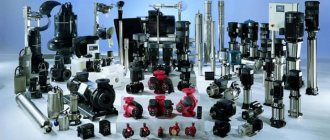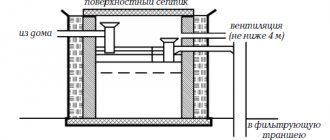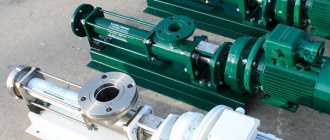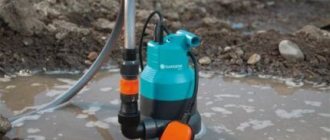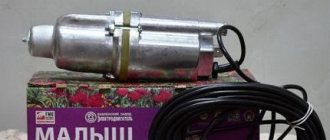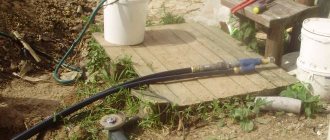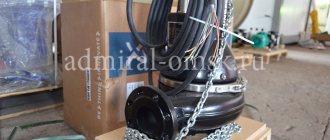- Design features and operating principle of the pump
- Drainage pump device
- Operating principle of the drainage pump
- Differences between drainage and fecal devices
- Video: types of drainage pumps and their scope of application
- How to choose a drainage pump
- Which pump is better - submersible or surface pump?
- Selecting a pump based on its main characteristics
- Video: instructions for selecting a drainage pump
Drainage pump
Equipment functionality
Pumping equipment is designed to transport liquids from a source to end points. In this case, the functionality is forced by connecting the device to the electrical network. The drainage type of devices differs from other analogues in that the transported water may contain solid particles of one or another fraction. The parameters are determined differently for each model. As a rule, household samples are capable of passing impurities ranging in size from 3 to 20 mm. For more powerful devices and industrial units, the limit values reach 38-120 mm.
Initially, drainage pumps were designed to eliminate emergency situations during leakage of sewer pipes and water supply systems. In addition to draining flooded basements, the equipment can be used to pump out contaminated liquid from ditches, pits, mines, pits, and treatment plants. It is also permissible to operate the devices in the case of collection points for fecal wastewater. There are specialized pumps for them, but such units are not able to cope with the fraction of solid particles above 2-2.5 mm. This requires an additional chopper.
Example of a fecal pump with a grinder Source vodotehnika.ru
Design features overview
The drainage pump device is represented by a plastic or metal sealed casing, inside of which is a built-in motor equipped with blades (impeller or impeller). A filter grid with cells of a specified size for a specific model is installed at the bottom of submersible devices. The parameter corresponds to the maximum permissible fraction of solid particles passing through the pump.
The working process of the drainage pump is as follows:
- when starting, the engine drives the shaft with the impeller;
- a discharged space is formed inside the housing in the area of the blades;
- due to the vacuum, the liquid begins to be sucked into the pump chamber;
- the blade elements also provide centrifugal force;
- As a result, water with impurities is pushed under pressure from the working chamber into the outlet, then into the hose attached to the pipe.
An example of a drainage pump with a float mechanism Source indclimat.ru
See also: Catalog of companies that specialize in engineering systems (heating, water supply, sewerage and others) and related work
Most types of devices are additionally equipped with circuit breakers. They are triggered when the water level in the source reaches the minimum set by the sensor. Its role is often played by a float for a drainage pump - this is a small box made of lightweight plastic with air inside. An alternative solution is an aquasensor, which is triggered at a water level of 5 mm. Such units are relevant for working in narrow channels where it is physically impossible to place a float.
An example of submersible equipment with an aquasensor Source zubr-vrn.ru
This way the device will not run idle and overheat. The latter phenomenon is eliminated provided there is water, which also serves as an engine coolant. It is worth noting that it is precisely because of this that there are restrictions on operating the pump in a heated environment. Either this is determined by the maximum permissible temperature (for example, up to +50 degrees Celsius), or by the time interval of operation under specific conditions.
Also, to avoid overheating of the device, the equipment is equipped with a thermostat. The device is configured to operate when a certain temperature (critical) is reached inside the housing. Then the sensor, like a float mechanism, turns off the power to the engine.
How does a drain pump work?
Drainage pumps can be divided into two fundamentally different types:
- superficial;
- submersible
To determine which sump pump is best for a particular job, it is worth understanding the characteristics of each type of device and understanding how a sump pump works in different conditions.
Surface pumps, an example of which can be seen in the photo, are installed above the water, near the pit. Water is pumped out using a hose that is immersed in water and reaches the bottom of the tank. The device can also operate in automatic mode, but it requires a float mechanism to control the liquid level in the tank. The rise of water also raises the float, which acts on the control elements and turns on the pump (more details: “Drainage pump with a float switch, device and principle of operation”).
The drainage pump must have two pipes: an input pipe, through which waste water is supplied from the tank, and an output pipe, which carries water outside the container being filled.
Surface pumps must be protected from water getting into the motor, since in this case it may fail.
That is why the pump power must be sufficient to pump out liquid at a speed exceeding the rate of rise of water in the pit. Professionals advise using pipes to connect the pump to the sewer, but to do this you need to know the exact diameters of the pipes that will be connected. Surface drainage pumps are quite mobile and easy to maintain. If necessary, the device can be easily moved to another place where liquid pumping is required, and problems that arise can often be eliminated in the field, since the design is quite simple.
Submersible drainage pumps operate on the same principles as surface pumps, so the differences lie in the design of the devices. Firstly, the very name of submersible devices indicates the need to immerse them in water, and secondly, this fact determines the operating principle of such devices: liquid is pumped by the pump itself, without the use of hoses or pipes. Water is sucked by the pump through a hole in its bottom, and the structure is equipped with a filter to protect against solid particles.
Types of pumps
To understand how to use a sump pump, you need to understand how it works. Depending on the device, there are only two types of equipment: surface or submersible type. Let's look at the features of each of them in more detail.
Surface type
Such equipment is installed above the surface of the water surface in one source or another.
An example of a surface device for pumping out dirty water Source yandex.net
Household use
Many people are rightly interested in how to properly use a household drainage pump.
The big advantage of the drainage unit is that its design is quite simple. Therefore, anyone who does not have experience or special knowledge can master the principles of operation.
If you don't know how to properly use a drainage water pump, refer to the following principles.
- Connect the pipe to the outlet. The submersible pump has one. The external type of drainage pumps additionally have a suction hose. Fastening is usually achieved with clamps. This eliminates the formation of leaks during operation. Pipes are selected by diameter based on the characteristics of the pump. Usually the manufacturer prescribes these points in the instructions and operating manual. This relates to the question of what hose will be needed to operate the drainage pump.
- Immerse the pump in the liquid medium. It’s just not worth putting it on the bottom. Typically, stands are used, or the unit is suspended above the bottom. This prevents clogging of the inlet openings. With surface drainages everything is simpler. Only the inlet pipe and float, which are held on the cable, are immersed in water. In general, installing a drainage pump in water is not difficult. But it is important to do this correctly so that the entrance holes do not stand on the ground. Otherwise, instead of water, the device will begin to suck in dirt, sand and other debris. The filters will not last long and will soon become clogged.
- Start the system. Pumping out water using a submersible pump is as simple as possible. The only requirement is to periodically check the condition of the filters. They must not be allowed to clog. For external systems, suction is started through a pipe. Moreover, it is important to first start the system and then send the pipe into the liquid.
Maintaining a sump water pump is quite simple. Usually the user only needs to clean the filter and check the condition of the pipes and hoses.
There are no particular difficulties with how to correctly and competently use the considered drainage pump.
Hose selection
Separately, you should consider the optimal diameter of the hose that will be needed to connect the drainage pump. Plus, some of its other characteristics also play a role.
The following recommendations can be given in this regard.
- Diameter. Directly affects the length. It is considered one of the key parameters for the effective operation of a drainage pump. Most often, hoses with a diameter of 32, 40 and 50 mm are installed on such pumps. But the smaller the diameter, the higher the likelihood of clogging. Therefore, in sewer systems where a drainage pump is used, it is recommended to use larger diameter pipes.
- Length. Here they are guided by the following principle: one meter of depth in terms of the required power corresponds to 10 meters in the horizontal plane. For example, if the depth of the pit from which the liquid is pumped is 5 meters, then the length of the hose is chosen to be 50 meters. But here the pumping speed will be small, since the length of the outlet along the ground must additionally be taken into account. Therefore, a reserve of about 3 meters is usually added to the calculated indicators.
- Temperature resistance. Often drainage units have to work at different times of the year. Therefore, the hose should not lose elasticity or deform during temperature changes.
- Material of manufacture. The optimal solution would be a vinyl or PVC hose. The material is the most resistant to various influencing factors.
Knowing all these points, you can choose the right components, assemble the pump unit and count on long-term and trouble-free operation.
Recommendations for choosing equipment
Submersible pumps are made with a housing made of plastic or metal. The first option is damaged more quickly by the passage of solid particles, so its service life is relatively short. On the other hand, it is better to choose surface samples with less weight to simplify the transportation of equipment. There is also a lower level of noise emitted during operation.
Model of a submersible pump with a metal casing Source ngorod60.ru
Important criteria for choosing a drainage pump are the fraction of impurities and power. The latter determines the maximum depth of the water source. These parameters are different for all models. Submersible type samples are considered optimal, as they work better throughout the year.
Regarding productivity for the private sector, experts often focus on 180-200 liters per minute. The pressure or force of pushing the liquid out is directly reflected in the length of the connected hoses. As a rule, for every meter submerged in water there is 10 m of horizontal channel.
Submersible drainage pump for dirty water: a universal assistant in the household
In one of the articles we talked about garden pumps, their modifications and characteristics, in this article we will talk about submersible drainage pumps for dirty water. Garden pump: how to choose a submersible pump for a summer residence (read more)
Owners of suburban areas constantly have to solve the problem of the accumulation of polluted water. To drain wastewater, it is necessary to use special equipment, which is represented by drainage units. about what a submersible drainage pump , how to choose the right device and which models are in greatest demand from this article.
The submersible drainage pump for dirty water is designed for draining silted wells, storage tanks, pits and reservoirs.
Briefly about the main thing
A drainage pump is a device for pumping water with impurities of one or another fraction.
Household equipment is designed to operate in reservoirs of various depths, where the size of solid particles can reach 3-20 mm.
To filter out impurities with a fraction larger than the permissible one, the devices are equipped with a filter element or grid.
There are two types of drainage pumps: surface and submersible.
Surface is recommended for seasonal use, installed next to a source of dirty water on a dry and level area.
Submersible can be with a lower or upper connection for water intake; it works directly in the aquatic environment.
To prevent the engine from overheating, thermal energy is transferred to the pumped water, therefore there are restrictions on temperature or operating time.
Automatic shutdown of the equipment occurs when one of the sensors is triggered: a float mechanism, an aqua sensor or a thermostat.
Ratings 0
How to choose a drainage pump
The selection of a drainage pump depends on the conditions of its use.
To buy a pump that is suitable and meets all requirements, you need to pay attention to what it is intended for and the following aspects:
- Terms of Use
. Despite the good performance of drainage pumps, their implementation can be difficult if the pumped water contains large solid fractions. Based on this parameter, we can draw the following conclusion: drainage pumps are excellent for pumping out water in the event of flooding in the basements of buildings. To dry the pond, you will need to create a solid and level support under the pump. For work on construction sites, it is better to choose fecal pumps equipped with a grinder.
Which brand is better?
The choice of brand indirectly affects the reliability of the device. This also takes into account budget constraints. The cost of 5,000 rubles is optimal for this type of equipment, allowing you to inexpensively solve problems with pumping water for more than one year. Based on this figure, several clear favorites can be identified on the Russian market:
Vortex.
The domestic leader among drainage pumps offers decent quality and optimal operating parameters. An affordable price greatly enhances the advantages of the product, making it the most popular on the Russian market.
Patriot.
Although the pump is assembled in China, the American brand remains true to its build quality and decent performance characteristics.
Karcher.
The German drainer, assembled in China, maintains unsurpassed operational reliability thanks to the German-thought-out design and the choice of materials used for vulnerable elements (pump parts).
Quattro Elementi.
The Italian brand produces a product with average performance characteristics, but high fault tolerance.
Quattro Elementi Drenaggio 400 F – copes with everyday tasks
Quattro Elementi Drenaggio 400 F
Quattro Elementi Drenaggio 400 F Among the Quattro Elementi pump line, only Drenaggio 400 F is designed for pumping dirty liquid (with fine pollution fractions up to 35 mm). The device can only be installed on a hill where there is no debris or waste.
The outlet pipe of the device is directed upward, but it is not recommended to immerse the product deeper than 2 m in water. The case is made of plastic, there is a mechanism to protect against dry running.
The device is too low-power to pump water out of a well or cope with a pit, but it can effectively pump out flooding from a basement or washing machine.
Advantages:
- works without a break for a long time
- silent
- there is an adjustable float level
- optimal price-quality ratio
- able to withstand dry running without breakage
Flaws:
- low power, suitable only for domestic needs
- does not turn on automatically when the water level rises
- short power cord
- large diameter outlet pipe
- sensitive to hose diameter and depth of descent
Current prices
Review Submersible pump ERGUS QUATTRO ELEMENTI DRENAGGIO 400 F, DRENAGGIO 550 F
Drainage pumps | TOP 10 Best: choosing assistants for pumping clean and dirty water + Reviews
Top 10. CALIBER NPTs-400/35P
Rating (2021): 3.95
35 reviews from resources taken into account: Yandex.Market, Otzovik
Best price The Chinese drainage pump CALIBR NPTs-400/35P will cost the owner 30% less than the popular model VORTEX DN-750.
- Characteristics
Country: China
- Average price: 2370 rub.
- Power: 400 W
- Capacity: 8 m³/h
- Particles up to: 30 mm
- Head: 6 m
- Immersion depth: 6 m
- Weight: 3.8 kg
To solve the issue of pumping out a drained septic tank or a flooded cellar, the budget option CALIBR NPTs-400 is quite suitable. This submersible pump is designed to pump 130 l/min of dirty water with impurities up to 30 mm in size. The maximum liquid temperature can be within 40 ˚C, which is optimal for domestic use. The model is designed to lift water from a depth of 6 m. However, in reviews, users note that this characteristic is a little overestimated. Overall the pump does the job well, it just takes a little longer. It lifts silt well from the bottom.
Advantages and disadvantages
- Stable work
- Low price
- Effective for septic tanks
- Weak pressure
GARDENA 8500 Comfort – monitors the water level
GARDENA 8500 Comfort
GARDENA 8500 Comfort The model allows you to pump and pump clean and contaminated liquid with particles up to 30 mm in diameter. If you install this pump permanently in the basement or in the basement, then there is no risk of flooding in the premises. Thanks to the Aquasensor system, the device automatically turns on when the water level rises above 65 mm.
The body is made of glass fiber reinforced plastic, which increases the performance characteristics of the device. The pump impeller is wear-resistant, and the capacitor motor is equipped with a thermal relay for overload protection.
The model has a universal outlet connector, which allows you to connect hoses with a diameter of ½.5/8, ¾, 1, 1½ inches. The pump is protected from dry running, there are manual and automatic modes.
Advantages:
- adjustable optical level
- low noise engine
- universal connector
- long cable allows you to work at great depths
Flaws:
- low power
- low bandwidth
Overview Pump GARDENA 7500 Classic, GARDENA 6000 Classic 1777
Drainage pumps | TOP 10 Best: choosing assistants for pumping clean and dirty water + Reviews
Current prices
BELAMOS DWP 1500/22 – powerful heavyweight
BELAMOS DWP 1500/22
BELAMOS DWP 1500/22 The device is designed for harsh operating conditions: it cannot be called compact, because the weight due to the cast iron body is 27 kg. However, in other parameters BELAMOS is ahead of its competitors: the device has one of the highest water pressure and power indicators.
Advantages:
- the impeller and pump housing are made of cast iron
- steel motor housing
- can be used for watering and pumping out silted wells
- high water pressure
Flaws:
- thin motor winding
- the model is not equipped with a cutting mechanism for crushing large fractions of contaminants
- low mobility of the device
Current prices
Checking the operation of the Belamos DWP 1500/18 drainage pump
Drainage pumps | TOP 10 Best: choosing assistants for pumping clean and dirty water + Reviews
What to look for when purchasing
Drainage pumps have a lot of indicators, properties and differences. How to determine which one is right for you? When purchasing, pay attention to the following parameters.
Characteristics of KARCHER mud drainage pumps
Particle size
What type of water will the pump be working with? Will there be impurities in the water? The device passport indicates the particle size that the pump can pump without harm to itself. It can be 5 mm, 35 mm, 50 mm and even more!
When working with dirty water for a long time, the filter on the drain pump may become clogged. It needs to be inspected and cleaned periodically.
Performance
Or bandwidth. Shows how much liquid the device drives through itself per unit of time. Sometimes this parameter is indicated in m3/h, and sometimes in l/min, or l/h .
Graph of performance versus pressure of a submersible pump
The speed of work will depend on this, and if you often have to pump a large amount of water, then this indicator (and it can vary from 10 to 230 l/m) is important!
Pressure
To what height or from what depth will the pump need to lift water? For drainage pumps, the pressure is usually small - from 5 to 20 m. When used horizontally, this figure can be safely multiplied by 10.
Slurry pump performance - pressure
For example, if the pressure of the purchased pump is 7 m, then horizontally it will be able to push water approximately 70 m. (Of course, the diameters of the hoses will also make adjustments).
Regular garden hoses do not fit into sump pumps. A special hose with a larger diameter can usually be purchased in the same place as the pump.
Power
An indicator that affects both the performance of the unit and the family budget. Only industrial devices have high power. Conventional household pumps are very economical.
Emptying level
Will you need to drain the container completely? If yes, then it is important to find out this parameter when purchasing.
Self-priming ability of the mud pump
The pump can “leave” 3-4 cm of water, or maybe only 2 mm. The difference is noticeable.
Emergency shutdown
As already mentioned, the float mechanism will turn off the device if the water runs out, and a special relay can stop operation if the engine overheats. The service life will be much longer if such a mechanism is provided.
Water temperature
Will it be necessary to pump hot water? Pumps tend to get hot, and most are designed for cold water. But there are special models that work with liquids of +50 and even +70°C. True, not for long (about 2 minutes).
To discharge wastewater, you cannot do without special equipment. Drainage pump - submersible and surface types, as well as installation and operation of the device. Read about how to make a drilling rig yourself in this topic. Algorithm for creating a manually driven system.
Materials
What are the housing and impellers made of? The particles will constantly grind the parts, and the gaps will affect the operation of the device. Therefore, it is good if they are steel.
There is also a vortex type pump with a magnetic drive that can pump toxic liquids.
Scheme of permanent installation of a drainage pump
So, a drainage pump is a very useful thing in the household! Models from German, Italian and Russian manufacturers are presented on the market. Prices range from 2000 rub. up to 80,000 rub. But, if you have about 7,000 rubles, this is quite enough to choose a high-quality drainage pump with all the necessary functions!
VORTEX DN-1100N – universal household assistant
VORTEX DN-1100N
VORTEX DN-1100N This pump is capable of pumping ground, drainage and filtration water from rooms and basements, regardless of whether the liquid is clean or dirty. With the same ease, the Whirlwind DN-1100N can handle supplying water from a well or borehole.
With this device there is no need to monitor the liquid level - the product is equipped with a float switch and will stop working immediately after pumping. The permissible number of starts per hour reaches 20, which allows high-quality work to remove excess liquid.
The diameter of the outlet pipe is ¼ inch, and the length of the cord is 8 m. The device operates at a voltage of 220 W and consumes a current of 3.6 Amperes. A comfortable handle is provided for transportation.
Advantages:
- metal case
- high power
- allows large soft particles of dirt to pass through
- light weight
- universal size pipe
- fast pumping
- silent operation
Flaws:
- the wire is not long enough and emits an unpleasant polymer odor
- Having difficulty cleaning the filter
- the impeller is made of plastic
Current prices
Review of the drainage pump VORTEX DN-1100N
Drainage pumps | TOP 10 Best: choosing assistants for pumping clean and dirty water + Reviews
Wilo Drain TM 32/7 – budget and mobile
Wilo Drain TM 32/7
Wilo Drain TM 32/7 Low-power submersible device, lightweight, compact, ideal for household needs. Suitable for stationary work (connected to a pipeline) and easily transported from place to place (connected to a hose).
The electric motor is equipped with a cooling jacket. Additionally, protection is implemented in the form of a thermal relay and end seals on the pump and motor sides. Withstands a maximum operating pressure of 10 atmospheres, therefore, despite the IP68 protection class, it is not recommended to immerse the device deeper than 1 m.
Advantages:
- fits even into narrow openings due to its compact dimensions
- silent engine
- easy to transport due to its weight of less than 5 kg
- automatic operating mode
Flaws:
- short cable length
- low power
Current prices
Wilo TM 327 drain pump with float switch
Drainage pumps | TOP 10 Best: choosing assistants for pumping clean and dirty water + Reviews
GILEKS Drainer 350/17 – unsinkable performance
GILEX Drainer 350/17
GILEKS Drainer 350/17 A submersible device designed to work with clean water. Allows you to filter particles up to 6 mm, plunging into the depth of 8 m. At the same time, the throughput of the device is 21 cubic meters per hour. Withstands the temperature of the pumped liquid from +1 to +35 degrees.
The pump is installed horizontally, equipped with a float switch to protect against dry running and an automatic water level control system.
The body of the Drainer is made of plastic. The device operates at a voltage of 220 W (50 Hz), and the length of the power cord reaches 10 m.
Advantages:
- high engine power and performance
- high pressure and pumping speed
- removable elements
- Possibility of disassembling the bottom to clean the filter in front of the impeller
- can stand at the bottom of the source thanks to the “skirt” base
Flaws:
- unreliable fastening of the plastic impeller
- massive parameters, does not fit into narrow spaces
Current prices
Drainage pump Gilex pumping out a septic tank for 120 meters
Drainage pumps | TOP 10 Best: choosing assistants for pumping clean and dirty water + Reviews
Table: comparison by characteristics
The best models, based on expert recommendations and consumer reviews, with a detailed analysis of their performance characteristics are presented in the table.
| Device name | Max. productivity, m3/h | Power, W | Maximum head, m | Immersion depth, m | Size of filtered particles, mm |
| 21 | 1200 | 17 | 8 | 6 |
Karcher SP 5 Dirt | 9,5 | 500 | 7 | 7 | 20 |
VORTEX DN-1100N | 15,5 | 1100 | 10 | — | 35 |
Grundfos Unilift KP 150-A1 | 9 | 300 | 5,25 | 10 | 10 |
Wilo Drain TM 32/7 | 9,5 | 320 | 7 | 1 | 10 |
PATRIOT F 850 | 13 | 850 | 10 | 7 | 35 |
GARDENA 8500 Comfort | 8,3 | 380 | 6 | 8 | 30 |
BELAMOS DWP 1500/22 | 16.2 | 1500 | 22 | — | 10 |
AL-KO Drain 20000 HD | 20 | 1300 | 10 | 5 | 38 |
Quattro Elementi Drenaggio 400 F | 7,5 | 400 | 5 | 2 | 35 |


